The dry bulk market could receive a boost from the existing condition in the Black Sea grain market. In its latest weekly report, shipbroker Intermodal said that “global grain markets continue to remain stretched. Drought, high temperatures, heavy rainfalls, poor yields, and geopolitical disruptions have been increasing uncertainty and lowering demand for bulk carriers. Rates for shipping grain, including soybeans, corn, and wheat have declined from 2Q2022 to 3Q2022, and they are also lower y-o-y. Moving toward the end of the year, the market has its eyes on China’s demand after a decision to ease its strict lockdowns, as well as the US, where the grain market has been hit by railroad disruptions, low river water levels, and poorer yields”.
According to Intermodal’s Research Analyst, Ms. Chara Georgousi, “earlier this month, the Xi administration agreed to ease its strict Covid restrictions measures, amid its effort to revive its pandemic-hit economy. Therefore, the market now expects to what extent China’s imports will be able to support global trade. In the grain sector, the country remains heavily reliant on imports, such as corn and soybean, as its domestic production does not suffice to fulfill its domestic demand. The current uncertainty due to ongoing geopolitical disruptions has rendered the country’s two main corn suppliers, namely the US and Ukraine, unreliable and as a result the country recently decided to turn to Brazil to secure its supplies, a move that threatens the US share of Chinese purchases. Meanwhile, in October the country materialized its lower soybean imports since 2014 and is now under pressure to replenish its inventories. The shortage has prompted Chinese authorities to consider allowing large-scale soybean meal imports, most likely from Brazil, following the country’s recent decision to open its markets to Brazilian corn imports. Consequently, soybean imports are forecasted to rise by 1.5m per month to 7.5m tons in November and to 9.5m tons in December”.
Ms. Georgousi added that “in the US, ongoing disruptions in the railways continue to shadow the market. U.S. Railroad labor contract negotiations continue without resolution but the potential for a strike has been moved forward into mid-December. While the harvest is wrapping up, the low water level on the Mississippi River is exerting more pressure on the railroad system. Grain handlers and suppliers are increasingly concerned over a potential crisis on the country’s railways and its ripple effects across the market. Albeit a recent improvement in the low water situation on the Mississippi River, a recent report released by the National Oceanic and Atmospheric Administration estimated that the drought affecting the river will most likely persist through January. As a result, grain is piling up as shippers are reluctant to ship grain with barges prior to January 2023, hoping for improved river conditions by early spring. For instance, during the first half of November a total of 36 oceangoing grain vessels were loaded in the Gulf, almost 49% lower y-o-y. By mid-November, barged grain movements totaled approximately 1.23m tons, and have been reduced by 29% y-o-y”.
Intermodal’s analyst concluded that “albeit a recent drop in ocean freight rates, mainly because of shrinking global trade and weak Asian demand for bulk grain products, and a rather gloomy outlook for the grain markets, there are still some factors that could underpin freights and demand for bulk vessels in the coming months. In the Black Sea region, the extension of the Grain Export Agreement for another 120 days, is expected to support Handysize and Supramax freight rates in the coming months. In addition, Panamax and Supramax vessels, which are primarily deployed in the Brazilian grain trade, could find some support from China’s demand through the year-end, after having suffered from a reduction in demand ton-days recently”.
Source: Hellenic Shipping News





